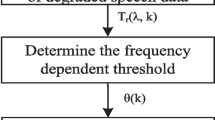Abstract
One of the effective technique to limit most of the unwanted noise irrespective of noise-frequency component is Active noise control (ANC) system. Filtered-x Least-Mean-Square (FxLMS) algorithm based on step-size parameter is used in ANC method to control noise. ANC system with small step size are stable than with large step size since large step size leads to sensitivity to any random change in noise. The proposed method develops a novel soft threshold based FxLMS (STFxLMS) algorithm with harmonic mean based variable step size (HMVSS). By constantly changing the step-size of this algorithm corresponding to the input noise signal and error signal recorded from the error microphone, the convergence rate of ANC system towards the desired output was improved. The improvement in noise reduction using HMVSS compared with fixed step was demonstrated using computer simulations. Anti-noise signal was also generated experimentally to limit the noise from noise source.













Similar content being viewed by others
References
Li, M., Duan, J., & Lim, C. L. (2010). Active noise cancellation systems for vehicle interior sound quality refinement. Recent Patents on Mechanical Engineering,3(3), 163–173.
Nelson, P. A., & Elliott, S. J. (1996). Active control of sound. Cambridge: Academic Press.
Kuo, M., & Morgan, R. (1996). Active noise control system: Algorithm and DSP implementations. New York: Wiley.
Paul L (1936) Process of silencing sound oscillations. In Google Patents.
Elliott, S. (2000). Signal processing for active control. Cambridge: Academic Press.
Elliott, S. J., & Nelson, P. A. (1993). Active noise control. IEEE Signal Processing Magazine,10(4), 12–35.
Kuo, S. M., & Morgan, D. (1995). Active noise control systems: Algorithms and DSP implementations. New York: Wiley.
Kuo, S. M., & Morgan, D. R. (1999). Active noise control: A tutorial review. Proceedings of the IEEE,87(6), 943–973.
Kuo, S. M., & Vijayan, D. (1997). A secondary path modeling technique for active noise control systems. IEEE Transactions on Speech and Audio Processing,5(4), 374–377.
Akhtar, M. T., Abe, M., & Kawamata, M. (2006). A new variable step size LMS algorithm-based method for improved online secondary path modeling in active noise control systems. IEEE Transactions on Audio, Speech and Language Processing,14(2), 720–726.
Nikias, C. L., & Shao, M. (1995). Signal processing with alpha-stable distributions and applications. New York: Wiley.
Shao, M., & Nikias, C. L. (1993). Signal processing with fractional lower order moments: Stable processes and their applications. Proceedings of the IEEE,81(7), 986–1010.
Ardekani, I. T., & Abdulla, W. H. (2011). On the stability of adaptation process in active noise control systems. The Journal of the Acoustical Society of America,129(1), 173–184.
Leahy, R., Zhou, Z., Hsu, Y.-C. (1995). Adaptive filtering of stable processes for active attenuation of impulsive noise. In 1995 international conference on acoustics, speech, and signal processing, 1995 ICASSP-95. IEEE: 2983–2986.
Sun, X., Kuo, S. M., & Meng, G. (2006). Adaptive algorithm for active control of impulsive noise. Journal of Sound and Vibration,291(1), 516–522.
Akhtar, M. T., & Mitsuhashi, W. (2008). Improved adaptive algorithm for active noise control of impulsive noise. In MWSCAS 2008 51st Midwest symposium on circuits and systems: 2008 (pp. 330–333). IEEE.
Akhtar, M. T., & Mitsuhashi, W. (2009). Improving performance of FxLMS algorithm for active noise control of impulsive noise. Journal of Sound and Vibration,327(3), 647–656.
Ghanbari, Y., & Karami-Mollaei, M. R. (2006). A new approach for speech enhancement based on the adaptive thresholding of the wavelet packets. Speech Communication,48(8), 927–940.
Donoho, D. (1995). Denoising by soft-thresholding. IEEE Transactions on Information Theory,41, 613–627.
Acknowledgements
The authors would like to thank the ELGI Ultra Industries Limited, Coimbatore for providing the details related to the noise generated by the mixer grinders and necessary aids to complete this project successfully.
Author information
Authors and Affiliations
Corresponding author
Additional information
Publisher's Note
Springer Nature remains neutral with regard to jurisdictional claims in published maps and institutional affiliations.
Rights and permissions
About this article
Cite this article
Saravanan, V., Santhiyakumari, N. An Active Noise Control System for Impulsive Noise Using Soft Threshold FxLMS Algorithm with Harmonic Mean Step Size. Wireless Pers Commun 109, 2263–2276 (2019). https://doi.org/10.1007/s11277-019-06680-9
Published:
Issue Date:
DOI: https://doi.org/10.1007/s11277-019-06680-9




